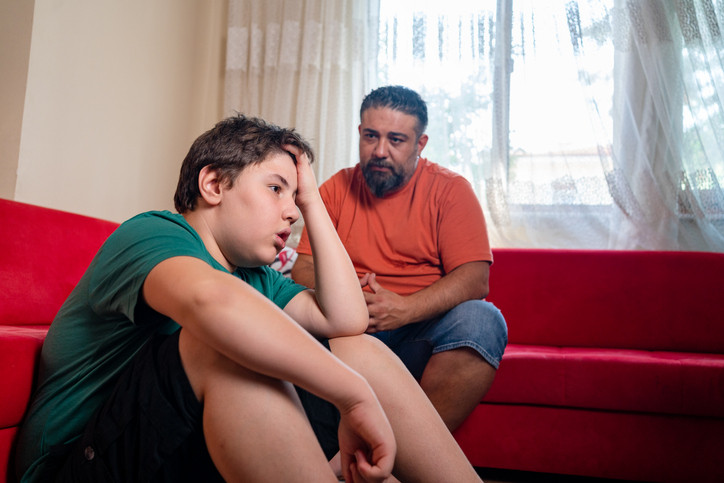If you’ve ever told yourself, “I just need to stay calm…” while your child is melting down — only to feel your heart racing or your voice rising — you’re not alone. Helping your child develop regulation skills starts with you — and it doesn’t always come naturally, especially when kids are pushing every boundary, the house feels upside down, or the long days of summer test everyone’s patience. But what if the key to steadiness wasn’t grit or discipline… but compassion? More specifically — compassion for yourself.
Self-Compassion Is Where Regulation Begins
We often think of regulation — the ability to monitor what’s happening inside us and adjust it — as something we’re supposed to master and then teach our kids. That’s partly true. But it doesn’t start with strategies or striving.
It starts with self-compassion.
When you offer yourself understanding and care in hard moments, your nervous system gets the message: You’re safe. And when your body feels safe, it’s better able to stay regulated — which is exactly what your child needs in order to regulate with you.
Therapist Bonnie Badenoch, PhD, sums this up simply: “Compassion is the neurobiology of change.”
“Compassion is the neurobiology of change.”
Why Self-Compassion Matters
Stress — whether from noise, conflict, or endless demands — can gradually push, or mercilessly throw your body into protection mode: fight, flight, freeze or collapse. But compassion interrupts that. When you pause, take a slow breath, or whisper some kindness to yourself, you engage your ventral vagal system — your body’s “social safety” system. And the more you do it, the stronger and more efficient that engagement becomes.
The ventral vagal system says: “You’re okay. You’re not alone.” It helps lower stress hormones, softens self-criticism, and makes your nervous system more flexible and resilient — exactly what your child needs you to borrow from.
Relational neuroscience (the study of how our brains develop, function, and change in the context of relationships — especially how connection with others shapes the brain’s wiring and affects emotion, behavior, and well-being) shows that safety can’t be forced with logic alone — your body has to feel it. This is why even simple moments matter: putting your hand on your chest, grounding your feet on the floor, humming quietly to yourself, or giving yourself a firm squeeze. These tiny shifts remind your body: Right now, I can settle.
Regulated ≠ Calm
One thing to remember (and give yourself loads of grace for): Regulated is not the same as calm.
Therapist Lisa Dion, founder of Synergetic Play Therapy, teaches that true regulation is about staying connected to yourself and others in the midst of nervous system activation. So you can feel your heart race, your voice firm up, or your eyes well with tears — and still be regulated.
It’s not about pretending you don’t feel what you feel in front of your kids. It’s about noticing what’s happening in your body and staying present with it…letting them see it, but also letting them see you moving through it and not get flooded by it. And when you do get flooded and your relationship with your child ruptures, you circle back later and repair it.
Robyn Gobbel, LCSW, explains it with a simple image: your nervous system has a gas pedal (activation) and a brake pedal (slowing down). Regulation means you know how to press either one, so you stay connected and balanced with your child, even when things feel big. Helping your child develop regulation skills means you are able to press your own brakes enough to be present with them.
Kids Can’t Regulate Alone — They Need Co-Regulation
Here’s the crucial part: kids, tweens, and teens cannot learn to regulate on their own. They’re born with a strong gas pedal (think babies… they cry… a lot!), but very weak brakes. In fact, their prefrontal cortex — the brain’s “brake pedal” for impulses — is under construction well into their 20s!
That means they borrow your nervous system first. They learn what steadiness feels like through co-regulation — being supported by a steady, emotionally safe adult, again and again. Their brake develops in the context of their relationship with you, their primary caregiver.
Co-regulation isn’t about staying perfectly calm or fixing your child’s big feelings. It’s about how you stay with them in the chaos, using a few simple but powerful ingredients.
These four core pieces make co-regulation, the key to helping your child develop regulation skills, work:
1️⃣ Physical Presence
Your body is the first signal of safety. Sometimes the best thing you can do is simply be there. Even older kids and teens often need you closer than you think — not hovering, but accessible. Your body tells theirs: You’re not alone.
What this can look like:
- Sitting on the floor in the hallway outside a slammed bedroom door.
- Standing nearby as your child paces the room in frustration, without crowding them.
- Riding silently in the car together after a meltdown — eyes forward, body relaxed, presence steady.
2️⃣ Resonance Without Flooding
Co-regulation means letting your child’s distress register in you — you feel it — but you don’t drown in it. This shows them: I get it, and I’m not scared of your feelings.
What this can look like:
- When your child cries hard, you soften your shoulders, slow your breath, and maybe say gently: “This is so big for you. I’m here.”
- When they yell, you feel your own anger rise — but you ground your feet, unclench your jaw, and remind yourself: “I can handle this wave.”
- When they’re panicked or frozen, you keep your body open and your tone soft, signaling: “Your feelings are safe with me.”
3️⃣ Matching Energy
Your child’s brain wants to feel that you see how big their feelings are. Matching energy means adjusting your voice, body language, or intensity so they feel met — but not overpowered.
What this can look like:
- If they’re yelling, maybe your voice gets firmer too — not to dominate, but to hold the space steady: “I hear you. I’m right here.”
- If they’re frozen and quiet, you soften your own tone and speak less: “It’s okay to sit here. You don’t have to talk yet.”
- If they’re bouncing off the walls, maybe you join them for 30 seconds of playful rough-and-tumble — then help guide them into a slower rhythm.
4️⃣ Mutual Influence (The “Dance”)
Co-regulation is not one-sided — it’s a back-and-forth dance. You respond to them, they shift, you adjust again. Some moments are beautifully in sync; others feel clumsy. Both are normal.
What this can look like:
- You move in for a hug but they turn away — so you pause, back off, and say: “I’m here if you want me.”
- They shout, you steady your tone, they soften — so you soften too.
- You notice when to give space, when to lean closer, when to speak, when to stay silent — not perfectly, but with openness.
These ingredients work together to help your child’s nervous system learn over time: “Big feelings don’t have to be dangerous. I can be messy and still loved. I’m not alone.” That’s how co-regulation plants the seeds for true self-regulation down the road.
For Kids Who Need More
Some kids’ nervous systems are naturally more sensitive, reactive, or slower to settle. This is not something you caused — it’s part of how they’re wired. They may need even more co-regulation, and continue to need a higher level of it later into their development.
Kids with ADHD, autism, anxiety, sensory processing differences, early trauma and attachment disruption, or chronic health conditions often live in a state of heightened alertness. Their brains hit the gas pedal fast and struggle mightily to find the brake. This might look like:
- A child who melts down every day after school because holding it together all day drains their reserves.
- A tween who explodes in rage, then feels shame they can’t put into words.
- A teen who shouts, “Leave me alone!” but feels abandoned if you do.
- A kid who hides under blankets or squeezes into tight spaces because deep pressure helps their body settle.
- A child who goes quiet and “refuses to talk” because they’re overwhelmed by sensory input or big emotions they don’t yet understand.
For these kids, repeated co-regulation is the intervention. Over time, your steady presence rewires their nervous system to know: “I can come back into balance.” Maybe not today or tomorrow, but slowly, over many moments, their brain’s brake pedal grows stronger.
Sometimes this means you talk less and sit close. Other times it means you respect their need to move — jumping on the trampoline or swinging helps their body release stress. Most of the time it means you tolerate more “big behavior” while focusing less on stopping it and more on staying with them through it.
When you wonder, “Shouldn’t they be able to do this by now?” — remember: you’re not spoiling them. You’re building the foundation they’ll stand on as older teens and adults. This is the real work — and it matters more than you know.
You Need Co-Regulation Too
Parenting a child with a sensitized nervous system is exhausting — especially if you didn’t grow up with this kind of support yourself. If you find yourself snapping, freezing, or wanting to disappear, that doesn’t mean you’re failing. It means you need co-regulation too. Helping your child develop regulation skills can only happen if you’re regulated, and you can’t always do that by yourself.
Text a friend. Wrap yourself in a blanket. Step outside and feel the breeze. Pet the dog. Hum softly. Picture someone who makes you feel safe. Let your own nervous system rest. Every bit of support you receive makes it more possible to offer that steady presence your child needs.
Try This Next
This month, in the middle of summer’s [often beautiful, but sometimes not so beautiful] chaos, we’re sharing two free resources to help you practice this in real life:
1. 5 Self Compassion-Infused Regulation Strategies for Dysregulated Parents
Practical, body-based tools to help your own nervous system settle — so you can show up steadier when your child’s world spins sideways.
2. How to Co-Regulate Your Child
A real-world guide for what to do in the moment — door slams, shutdowns, big words like “I hate you!” — and how to respond with connection instead of losing yourself too.
Both of these handouts are available in our Free Resources Library, and all you need to do to get access is sign up for our monthly Newsletter!
You don’t to be calm all the time, and you certainly don’t need to be perfect. You just need to be human, practice compassion for yourself, and keep coming back to connection — again and again.
We’re here with you, every step of the way.


